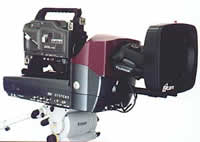JVC ZCAM 3D Real Time Depth Sensing Camera System
JVC Updated: 2008-04-07 RSS
The desire to detect not just the colors of objects, but to capture distance and dimension information is not new. Techniques that have been tried are time of flight, active triangulation, stereovision, range from de-focus, structured illumination and Moiré contouring.
However, none of these techniques work outside of a controlled environment and none offer real-time performance because they use a technique where information is measured and calculated one pixel at a time. 3DV's proprietary and patented Parallel Range Sensing (PRS) technology is the only solution that works in all environments and in real-time.
Unlike 3-D scanning solutions, which only work for still image capture and in controlled environments, the 3DV video object capture solution contains no moving parts such as rotating mirrors that can move around or break. As described below, scenes are not scanned and calculated one pixel at a time, but captured and optically processed as a whole image.
The 3DV object video image sensor is fast, versatile and reliable. It can capture object information at a rate of over 60 frames per second-thus satisfying even the rigorous demands of broadcast television and high-end video production.
The range of the sensor depends on the strength of the pulsed, infrared illumination source since the amount of light scattered back from the scene depends on the reflectivity of the objects and the strength of the illumination. It is currently set to 30 feet. This is sufficient for most applications since the resolution of the distance information can be focused on a particular object and dynamically tracked as the object moves relative to the camera. Thus, the camera can detect and track even detailed surface information such as wrinkles in a face.
Besides the image sensor, the 3DV object video solution is made up of an illumination source that sends out a pulsed infrared signal, a pulse control chip and a DSP chip. As illustrated in the diagram below, to capture object dimensions and distances in a scene, the DSP chip sends out a signal to the pulse control to start flooding the scene with pulses of infrared light. The pulse control shapes characteristics of the pulses such as pulse duration, the number of photons per pulse and signal rise/drop-off.
The pulses get contoured and reflected by the objects in the scene. The object video sensor then measures the accumulation of photons to determine the exact distance of each pixel in the scene. The signal then travels to the DSP chip, which performs the calculations essential for object tracking, interpolations and noise reduction.
In the simplest case, the output of the 3DV-enabled camera is an object mask that separates an object from its background and that can be fed into industry-standard switchers. As illustrated below, the mask that is generated below is the key information for the switchers, so that it can determine which source of video to put in front of the other.
For example, a regular video camera would just be able to record the frame to the left below. A 3DV-enabled camera in addition captures a multi-layer object mask like the one on the right:
This mask can get generated in the natural context of the scene (no special studio setup required). In addition, 3DV-enabled cameras can not only separate a single object from a color-keyed background, but they can isolate several objects via distance-keying. Once this object mask is created, the person in the foreground can be shown with just one or two of the people present, and a nature scene can be inserted in real-time to replace the office environment.
However, the 3DV image sensor can do much more than just simple background replacement and the deletion/insertion of objects. It can interface with virtual set software to apply live effects to any object in the video. The object information can also be saved for applications where video footage is recorded and undergoes a post-production process. Via DeepEdit, producers can import and edit object video footage inside industry-standard video editing and 3-D animation packages. For the latter, the DSP generates fully textured, polygonal 3-D objects-thus reducing cost and time required for 3-D modeling.
As illustrated below, the 3DV solution fits seamlessly into the existing video capture, production and distribution environments. The image sensor does not require a special camera, but can be used with all major studio cameras. 3DV's software solutions allows broadcasters to expand the capabilities of their virtual set software; video artists can save time and gain new creative capabilities by importing object video into their favorite post-production applications.
The resulting video is broadcast without further modifications via the airwaves or existing cable channels, and it is received by consumers with the equipment they already own today: either a standard TV set or a Internet-connected PC with video player software such as RealPlayer or Windows Media Player.
No manuals currently available for this model.
Related Manuals
JVC KY-27BUCH 3-CCD Color Camera Head
JVC DY-700U D-9 Camcorder Head
JVC DY-90WU D9 Switchable Camcorder
JVC GY-DV500U Professional DV Camcorder
JVC GY-X2BU S-VHS 3-CCD Camcorder Less Lens
JVC GY-X3U S-VHS 3-CCD Camcorder
JVC GY-DV700WU Pro-DV 16:9 Camcorder
JVC DY-90WUCL D-9 Cineline Camcorder
JVC GY-DV700WUCL Cineline DV Camcorder
JVC GY-DV300U 3-CCD DV Camcorder
JVC GY-DV5000U 3-CCD Professional DV Camcorder
JVC GZ-S3U 1-Tube Camera